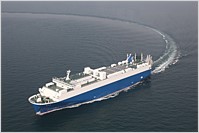Enhancing Transport Efficiency
Nissan began sending chartered trucks for pick-up and delivery of parts in 2000, a method that was uncommon among automobile manufacturers in Japan at the time. This approach has also been adopted widely at our overseas manufacturing sites, increasing the global efficiency of our operations. We have also worked together with suppliers to optimize the frequency of deliveries and transport routes and to improve packaging specifications.
Much effort is dedicated to devising efficient modes of packaging for the huge number of parts of different shapes and materials that go into each automobile. Through simultaneous-engineering logistics activity, we are working from the design stage to create parts and develop new vehicles with consideration for transportation efficiency, as well as to reduce the parts shipments per vehicle.
In the area of container transport, we have long made use of high cube containers and run software-based simulations to reduce wasted space inside of containers.
We have reviewed our transport methods and are undertaking a modal shift from truck to maritime and rail transport. Some 80% of our completed vehicles in Japan are transported by sea. Parts shipments from the Kanto area around Tokyo to our Kyushu Plant are nearly all by rail and ship. The Japanese Ministry of Land, Infrastructure, Transport and Tourism has recognized Nissan as an outstanding enterprise for this modal shift to sea transport.
At Nissan sites outside Japan, transport methods are selected to best match the local geographical conditions. We are also shifting from truck to rail and ship for completed vehicle transport, depending on the destination. In China, we are increasing the proportion of completed vehicles that are transported domestically by ship or rail.
Energy-Efficient Car Carriers
Nissan is promoting use of energy efficient car carriers to reduce CO2 emissions in our global logistics. Following "City of St. Petersburg" (December 2010), "City of Rotterdam" (April 2012) in Europe, and "Nichioh Maru" (January 2012) in Japan, we introduced "Nissei Maru", a sister ship of "Nichioh Maru" and our 4th energy-efficient car carrier, to Nissan's logistics shipping route in January 2013. The Nissei Maru is equipped with an electronically controlled diesel engine, solar power panels and LED lighting in the ship's hold and living quarters. Its hull is painted with the latest low friction coating, among other energy-efficient features. Compared with the existing car carrier of the same type, the Nissei Maru saves as much as 1,400 tons of fuel annually, and reduces CO2 emissions of about 4,200 tons.

One of Our Energy-Efficient Car Carriers (“Nichiou Maru”)

